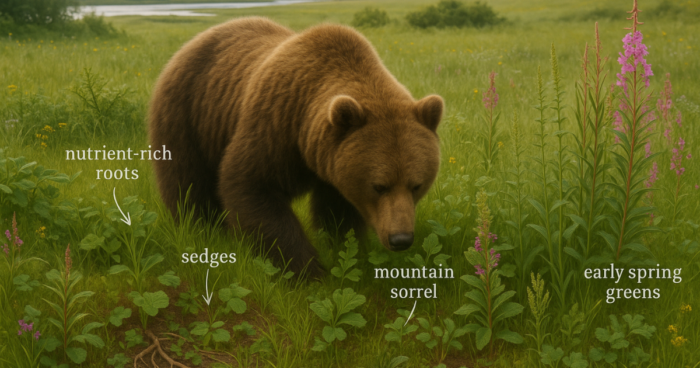Favorite Forage Plants: Beyond Salmon & Berries in Bear Diet
While salmon and berries are well-known bear foods, favorite forage plants play a significant role beyond these staples in the bear diet. Bears in Alaska display a remarkably omnivorous diet, shifting their feeding strategies with seasonal availability to meet nutritional needs. This plant-based portion of their diet is critical to survival, especially during periods when animal protein is scarce. Nutritional ecology and the diversity of vegetation across ecosystems contribute to how bears adapt and thrive in different regions.
The Bear Plant-Based Diet and Dietary Diversity
Bears have a varied plant-based diet that includes roots, grasses, and other vegetation critical for their nutrition. These foods provide essential fiber, vitamins, and minerals, which support the overall health and energy levels of bears, especially in the pre-hibernation season.
Bear dietary diversity allows them to consume a wide range of plant matter, from early spring shoots to fall roots. This adaptability is a key trait in their survival, particularly in fluctuating climates and environments across Alaska.
Key Alaskan Bear Forage Plants Beyond Salmon & Berries
Alaskan bear forage plants include a surprising range of species beyond the usual salmon and berry staples. These bears consume plants like devil’s club, horsetail, and cow parsnip, often found in forest edges and riverbanks. Seasonal plant foods for bears change as the ecosystem transitions, pushing bears to adapt their foraging routes.
Roots and tubers in bear diet, such as those from wild horsenettle and angelica, offer rich energy sources in late summer and fall. These carbohydrate-rich foods are essential in fat accumulation before hibernation.
Grasses and sedges eaten by bears, particularly during spring, provide easily digestible roughage. Sedge meadows and open fields become key feeding sites during this period. This herbaceous vegetation often dominates early diets when berries and fish are less available.
Foraging Behavior and Nutrition from Vegetation
Foraging behavior in bears changes with plant availability and habitat type. They use a combination of scent tracking and memory to revisit sites with high nutritional yield. Bears often dig, strip, or graze, depending on the food source and season.
Bear nutrition from vegetation includes a mix of energy-dense roots, vitamin-rich shoots, and hydrating leafy greens. These plant foods complement animal proteins, helping maintain energy balance throughout the active seasons. Many wild plants also contain secondary metabolites that play a role in digestion and overall immune health.
Herbaceous Plants and Wild Edible Plants in Bear Diets
Herbaceous plants for wildlife are a foundation of Alaskan ecosystems, offering sustenance for a variety of animals, including bears. Bears often forage in wetland edges and alpine meadows for these soft, easily digestible plants.
Wild edible plants for bears include glacier lily, fireweed shoots, and clover. These species thrive in disturbed areas and transitional zones, providing reliable food sources throughout spring and early summer. Bears’ interaction with these plant communities can influence seed dispersal and soil composition, making them integral players in ecological cycles.
Species-Specific Foraging: Brown Bears vs Grizzlies
Brown bears in coastal regions have access to denser plant growth and diverse flora, while interior grizzlies rely more heavily on roots and hardier plants due to limited vegetation. This variation reflects species niche differentiation and dietary specialization across habitats.
For a deeper understanding of dietary and behavioral differences, see our comprehensive article on brown bear vs grizzly bear.
Conclusion
While salmon and berries are iconic components of their diet, favorite forage plants play a significant role beyond these staples in the bear diet. From spring greens to autumn roots, bears rely on plants to meet key nutritional needs. This dietary flexibility allows bears to thrive across varied Alaskan landscapes and changing seasonal conditions. Learn more about species differences in our pillar guide: brown bear vs grizzly bear.


